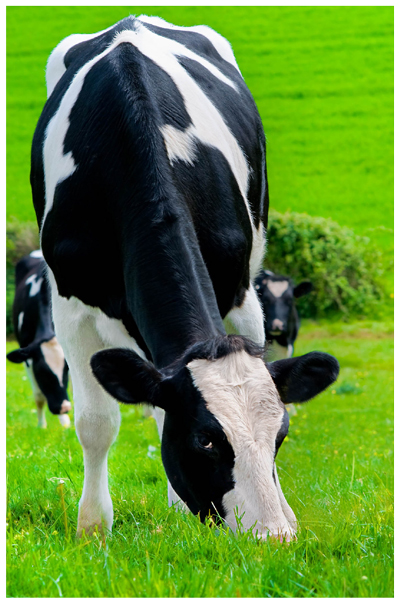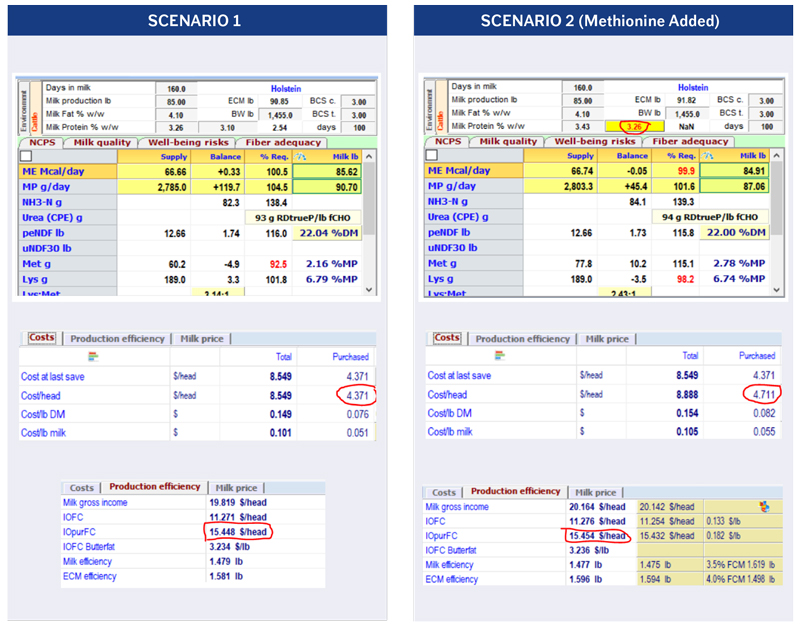Focus On Profits For Dairy Success
Click here to view as a pdf: Focus on Profits For Dairy Success
When sitting down with current and prospective dairy clients, the conversation regularly revolves around farm goals and benchmarks. This is important to make sure the dairy is headed in the direction the owners are striving for. Different dairies may have different goals, which is just one reason the dairy industry is so amazing. It is not unusual though, to find that farms may be scope locked on milk production as a goal without other context to go along with it. Milk production is very easy to measure daily, it has long been a metric of success, and let’s be honest, it is a lot of fun when cows are making a lot of milk. However, milk production alone does not equal profitability for the farm. Profitability, or at least income over feed cost, should be the focus on dairies and is what truly measures success. Profit is harder to measure and track but yields more positive results. Crystal Creek® works with clients to track profitability and comb through data to find opportunities for improvement. This includes tracking and monitoring feeding software programs, understanding of herd management software, DHIA report review and analysis, and diet evaluation to maximize profitability, not just milk production.
Increasing long term profitability and economic sustainability usually revolves around the big picture of the dairy. Seldom is the key to unlocking a dairy’s potential hidden in an expensive ingredient added in the ration to get two more pounds of milk. Crystal Creek® helps producers look deeper into their operation to find larger bottlenecks like:
- Heifer inventory as a percentage of the milking herd
- Average herd age and demographics
- Heifer performance compared to aged cows
- Reproductive assessment
- Which breeding methods are working, and which aren’t?
- Patterns in days of the week or by technician
- Patterns by service number
- Early embryonic death loss
- How can we get more cows pregnant on natural heats?
- Cull rate
- Why are cows leaving?
- Cow comfort and time budgets
- Is cow comfort robbing you of production or health?
- Are cows getting enough time to rest, eat, ruminate, and express normal behavior?
- Forage quality assessment
- What changes can be made to increase forage in the ration and maintain or increase cow performance and health?
 Along with looking for bottleneck areas to make improvements, Crystal Creek® tracks economic data over time. This helps compare each dairy to itself and make sure the trend in profitability is increasing. This also points out times in the year or events which either improve or hinder profitability.
Along with looking for bottleneck areas to make improvements, Crystal Creek® tracks economic data over time. This helps compare each dairy to itself and make sure the trend in profitability is increasing. This also points out times in the year or events which either improve or hinder profitability.
Crystal Creek® uses NDS Professional ration balancing software which has impressive economic tracking features. Figure 1 is an example showing the Income Over Feed Cost with each ration tracked over time.
NDS easily generates gross revenue reports of total farm economics and profitability using revenue numbers from the lactating groups and then subtracting all feed costs including the costs of feeding youngstock. This can be extremely helpful for meeting with banks and identifying potential problem groups of the dairy.
It is not uncommon when looking at competitive feed companies’ rations to see a laundry list of ingredients, some being very expensive. The producer may not know why the product was added in the first place, what the actual cost is, and if it is paying for itself. Crystal Creek® looks extensively at the cost of additives and what cow performance changes are needed to make sure the diet change was profitable. Below are two scenarios. In scenario 1, cows are making 85 pounds of milk with 4.1% butterfat and 3.1% protein. The purchased cost of the ration is $4.37 per cow per day. Income over purchased feed cost is $15.45 per cow per day. This example then compares with scenario 2 in which methionine, an amino acid, was added to the ration. This increased the purchased cost of the ration to $4.71, adding 34 cents per head per day. Adding methionine routinely leads to an increase in milk protein and often butterfat. Because NDS takes current class III component milk pricing into account, it can quickly be determined how much of response is needed to increase income over feed cost. In this case, a milk protein increase from 3.1 to 3.26 with no butterfat increase and no milk volume increase would pay for the addition of the methionine. This is a very realistic response to expect. Going through this process helps minimize risk for the producer and establishes the needed response to watch for in the cows. This increases profitability, empowers producers to make informed decisions about what is in their rations, and eliminates ingredients that are not making the farmer money.
Crystal Creek® takes a total farm approach to analyzing and maximizing profitability, looking at more than just milk in the tank when balancing rations. Crystal Creek® has the experience and ability to monitor farm data, track economic performance, and build rations with profitability as the primary goal. Contact a Crystal Creek® nutritionist today to look into the economic performance of your dairy and find opportunity.





